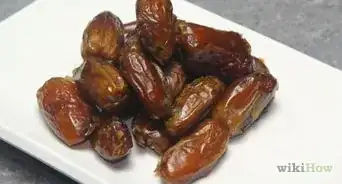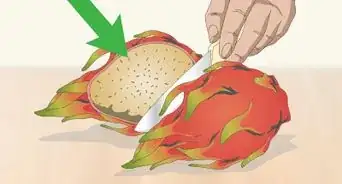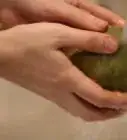This article was co-authored by Andrea Lawson Gray. Andrea Lawson Gray is a Private Chef and the Co-Founder of Private Chefs of the SF Bay. With more than ten years of experience, she specializes in Mexican cuisine and culinary history. Chef Andrea is also the author of Celebraciones Mexicanas: History, Traditions, and Recipes, an award-winning cookbook.
wikiHow marks an article as reader-approved once it receives enough positive feedback. In this case, several readers have written to tell us that this article was helpful to them, earning it our reader-approved status.
This article has been viewed 1,081,255 times.
Mangos are a tropical fruit that are delicious whether they are eaten plain, made into a juice, or added to some of your favorite dishes. If you've never eaten a mango before, you may not be sure how to tell whether it's ripe. Luckily, there are a few signs you can look for to test the ripeness of your mango, including the appearance and the texture of the fruit.
Steps
Check by Appearance
-
1Consider the shape. For most mango varieties, a round or football shape is preferable over a flat appearance. That said, there are specific differences between mango varieties worth keeping in mind.[1]
- The Ataulfo mango has a somewhat flattened oval shape when ripe. This variety is also usually quite small.
- The Francis mango is oblong and has a slight s-shape when ripe.
- The Haden mango is round to oval in shape. This variety is usually medium to large in size.
- The Keitt mango is a large, oval-shaped variety.
- The Kent mango is another large, oval-shaped mango variety.
- The Tommy Atkins mango is oval or oblong in shape. As for size, this variety is usually medium to large.
- The Alphonse mango has an oblong shape.
- The Edward mango can have both round and oblong shapes.
- The Kesar mango usually has a round shape.
- The Manila mango has a notably skinny, slender appearance.
- The Palmer mango has an oblong appearance.
-
2Check around the stem. The flesh and skin around the stem should be especially plump and especially round.
- Before a mango ripens, the stem end will be fairly flat. The pulp, juices, and sugars inside the fruit have not yet developed completely. Once the mango finishes developing and turns ripe, it should be so plump inside that the stem end rises slightly instead of remaining flat.
Advertisement -
3Do not fixate on the color. A red hue is often and indication of how much sun exposure a mango has received, not an indication of freshness. Moreover, the color of a ripe mango varies based on the mango variety. You should never rely only on color to determine if a mango is ripe, but if you want to use color as a backup indicator, you must first understand how certain varieties are supposed to look once ripe.
- The Ataulfo mango turns a deep, golden color when ripe.
- The Francis mango will be a blend of green and gold when ripe. The green tint of the yellow skin fades, gradually turning more gold. Note that some green will still remain, however.
- The Haden mango turns from green to yellow once ripe. This variety is more prone to reddening, as well, but it does not need to be red in order to be ripe.
- The Keitt mango will remain green even once it becomes ripe.
- The Kent mango will remain mostly dark green, but it often has yellow undertones or yellow dots over various portions of the mango once it ripens.
- The Tommy Atkins mango provides little to no visual clues. The skin can remain yellow-green, turn golden, or develop a dark red blush.
- The Alphonse mango has a purple to yellow skin once ripe.
- The Edward mango has skin that can be pink, yellow, or some blend of the two.
- The Kesar mango can remain green once ripe, but they often take on a yellow hue.
- The Manila mango usually has an orange-yellow hue when ripe, but occasionally, the skin can also turn pink.
- The Palmer mango can vary in color, often appearing purple, red, yellow, or some mix of the three.
-
4Note any speckles. While this is not always a sure indication, either, if the peel of a mango has developed a few brown spots or speckles, it is likely ripe.
- A mango lacking speckles may still be ripe, though, especially depending on the variety. Spots should not be relied on as your only indicator.
- Some mango varieties, like the Kent mango, can develop yellow spots instead of brown spots.
Check by Smell
-
1Choose a sweet smelling mango. Give the mango a good whiff right around the stem area. If the fruit has a strong fruity, sweet smell, there is a good chance that it has fully ripened.
- Sniff the mango near the stem end. The odor will be strongest there, and you will get a more accurate idea of how the fruit actually smells.
- The smell should remind you of the way a mango tastes. The senses of taste and smell are closely linked, and the way something smells greatly impacts the way it tastes.[2]
-
2Avoid a mango with a sour or alcoholic scent. If you sniff the mango near its stem and smell a strong bitter smell, this is a sign that the mango has over-ripened and is starting to rot.
- The mango has a very high sugar content when compared with many other fruits. As they start to go bad, these fruits will actually begin to naturally ferment. This explains the sour, alcohol-tinted smell. It also means, though, that the mango has over-ripened far too much. It will likely taste as sour as it smells.
Check by Touch
-
1Gently squeeze the mango. When you apply light pressure to the sides of the mango, you should feel the flesh “give” a little or indent. A soft mango is a ripe mango.
- A mango that does not cave to pressure or one that feels hard as a rock is nowhere near ripe enough to eat.
- Understand, of course, that the mango should not be squishy. If your fingers pierce the mango when you apply a small amount of pressure, the fruit is overripe.
- To avoid accidentally bruising the fruit, press with your palm instead of your fingertips. Hold the mango in the palm of your hand. Close your hand around the fruit, pressing on it with the ball of your palm.
-
2Feel the skin. Lightly rub your fingertips over the surface of the mango. Oftentimes, a ripe mango will have a few wrinkles somewhere on the skin.
- Note, however, that the absence of wrinkles does not necessarily signify that the mango is unripe.
- If deep wrinkles cover a large portion of the surface, the mango is likely overripe.
- The Ataulfo mango is especially well-known for developing wrinkles as it ripens. Other varieties may develop light wrinkles that are difficult to detect, while others could potentially stay smooth even after they ripen.
-
3Judge the weight. Pick up the mango and feel its heft in your hand. A ripe mango will feel somewhat heavy for its size and will feel heavier than an unripe mango does.
- If you need a better weight guideline, compare the weight of a potentially ripe mango with a mango you know is unripe. The unripe mango should feel notably lighter than the other mango if that other mango is ripe, especially if the mangoes are similar in size and of the same variety. If the two feel too similar in weight, the second mango is probably unripe, as well.
Ripening an Unripe Mango
-
1Place the mango in a brown paper bag. While this is not strictly necessary, putting the fruit inside of a bag will help speed up the ripening process.
- Fruit naturally produces ethylene gas as it ripens. The presence of ethylene hormone will trigger further ripening, and the brown paper bag traps ethylene produced by the ripening mango.
- Placing an apple or banana in the bag along with the mango can speed the process up even further since these two fruits are known to produce high levels of ethylene.
-
2Sit the mango out at room temperature. Check the mango each day, using the methods mentioned here, to determine if it has ripened yet.
- This can take anywhere from 2 to 7 days, depending on how unripe the mango is when you start.
- Do not store an unripe mango in the refrigerator. Cold temperatures dramatically slow the ripening process, and an unripe mango will likely go bad in the refrigerator before it has a chance to ripen.
-
3Move the mango to a refrigerator once ripe. A ripe mango must be eaten immediately or stored in the refrigerator for up to five days.
- The cold temperatures that are the natural enemy of an unripe mango are the best friend of a ripe mango. If you leave a ripe mango on the counter at room temperature, it will go bad within the day. In a cold refrigerator, though, it can usually stay ripe and fresh for at least four days, if not five.
Community Q&A
-
QuestionWhat color is a mango when it's ripe?
 Community AnswerThat depends on the type of mango you have. Different mangoes have different colors, like strawberries. Ripe mangoes typically have speckles of brown, but this isn't always the only indicator of a ripe mango. Try smelling the fruit near the stem. If it has a sweet scent, it's safe. An alcoholic scent tells you the mango is overripe, so don't select that mango. If it smells like you would eat it, you can eat it.
Community AnswerThat depends on the type of mango you have. Different mangoes have different colors, like strawberries. Ripe mangoes typically have speckles of brown, but this isn't always the only indicator of a ripe mango. Try smelling the fruit near the stem. If it has a sweet scent, it's safe. An alcoholic scent tells you the mango is overripe, so don't select that mango. If it smells like you would eat it, you can eat it. -
QuestionIs a mango bad if it has an acidic, burning taste?
 CaeiiaTop AnswererIt might not be ripe enough, or you may be allergic to the skin.
CaeiiaTop AnswererIt might not be ripe enough, or you may be allergic to the skin. -
QuestionI just peeled a mango, and the color was a faded orange with a light brown color around the pit. Is it okay to eat?
 Community AnswerIf it stinks, don't eat it. Or if you are courageous, take a small bite. If it tastes okay, go ahead and eat it.
Community AnswerIf it stinks, don't eat it. Or if you are courageous, take a small bite. If it tastes okay, go ahead and eat it.
Things You'll Need
- Brown paper bag (optional)
References
About This Article
If you want to check a mango for ripeness, hold it in your hand and squeeze gently with your palm. If the mango indents slightly, it’s probably ripe. If the mango is hard, it needs more time to ripen, and if it's squishy, it’s overripe and should be discarded. Next, run your fingers over the skin of the mango. Most ripe mangos will have some wrinkles in the skin, although some will stay smooth. Finally, test the weight in your hand. A ripe mango will feel heavier for its size than an unripe mango. For tips on ripening a mango, keep reading!























































